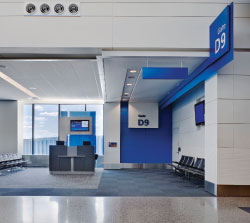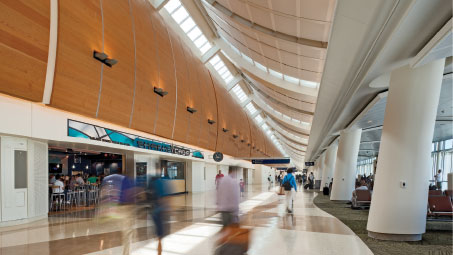
At Detroit Metro’s North Terminal, each gate is designed identically and each gate’s carrier is identified via a flat screen panel, enabling the gates to be used by multiple carriers. This flexible design increases the frequency of gate turnaround rather than physically expanding to meet increased air traffic demand. (Credit: David Joseph)
New challenges in the aviation industry confront executives every day. Airlines-faced with roller-coaster fuel prices, tightened credit, and declining ticket sales-are forced to look at new business strategies that include consolidation, bankruptcy, and reduction in seat capacities. Meanwhile airports, reacting to these industry trends, scramble to accommodate new carriers demanding space in their terminals.
Both sectors of the industry – airlines and airports – are working hard to develop strategies that will carry them through these difficult times. Ultimately, as airlines adapt to the new realities of air travel, airports will reinvent themselves and their business strategies. The result will be a “new airport” that sets the stage for an agile airline industry that meets the needs of passengers, airlines, and airports alike.
The low-cost carrier

Detroit Metro’s North terminal’s linear design enables aircraft to land via taxiway and pull directly into their respective gates. The linear configuration eliminates traffic jams typical of airports featuring alleys or piers. (Credit: David Joseph)
What factors are driving this transformation? Certainly one of the biggest is the emergence of the low-cost carrier (LCC). In particular, India, China, Indonesia, and Malaysia have witnessed a steady stream of new entrants into this lucrative market. But many airports lack the facilities to accommodate the operational approach and increased demand that an LCC creates.
To attract and retain this lucrative service, airports have had to be inventive. On the landside, the LCC business model relies heavily on passengers obtaining their tickets and boarding passes somewhere other than the airport ticket hall-mostly online. The result is a reconstruction of the ticket counter area to provide more places for bag drops and electronic check-in, which minimises the space airlines must rent. Once past security, LCC passengers will find smaller hold rooms in response to the reduced wait time enabled by quick aircraft turnaround.
On the airside, airports have had to reconfigure their aprons and taxi lanes to accommodate a single type of aircraft. Wider wingtip clearances facilitate quick turnaround by allowing the aircraft to come in “hot,” without wing walkers. The impact of this single requirement might affect the airport’s total gate capacity by requiring more terminal frontage without elimination of some adjacent, non-LCC apron positions. Existing passenger loading bridges may require relocation or new bridges will have to be procured.
The legacy carriers
Riding out the restructurings of 2005-2007, airlines were beginning to show profitability-until volatile fuel prices and a drop in ridership took their toll. In response, the legacy carriers shifted aircraft and personnel to more profitable domestic routes and the international sector. This realignment resulted in reduced domestic capacity for the legacy carriers, dropped routes being picked up by the LCCs, and diminished service to second- and third-tier cities. Conversely, the larger legacy carriers heralded new international routes made possible by “open skies” agreements. These airlines are asking airports to update, enlarge, or otherwise enhance terminals to allow increased international service.
Like the LCCs, the legacy carriers’ new business model has huge implications for airports. Airport terminal operators are faced with decreased demand for domestic gates. In cases where airlines have long-term leases on specific gates, airports are seeing unused gates that cannot be made available to other carriers. Where the legacy carriers have acquired new international routes, or wish to, airports are seeking ways to convert unused domestic gates to international swing gates and to develop new or expanded customs facilities. How to finance these capital improvements remains a problem.

The new North Concourse of the Norman Y. Mineta San Jose International Airport (SJC) is the first installment of a larger comprehensive master plan designed to meet the needs of 21st century air travel in San Jose and the Silicon Valley. (Credit: Sherman Takata)
The model is flipped
Airlines have long viewed their passengers as their customers; facilities were only a means to serve those customers. Airlines held long-term residual, exclusive-use gate lease agreements with airports, many with Majority in Interest (MII) clauses that made it difficult for airports to add new gates or amenities that would attract new entrants. Now, the model is flipped. Airports are realising that the passengers belong to them; the airlines only provide air service. Airports recognise this new opportunity and are focusing on controlling all aspects of the terminal to provide top-flight service to both passengers and airlines.
With airports seeking greater control of their facility-charging their tenants (including airlines) for what they use and when they use it-common-use airports and their compensatory agreements are beginning to transform the industry. When airports are unsure which, if any, airline will provide service in their facility, the common-use strategy removes a degree of uncertainty. This allows the airport to own its gates, loading bridges, ticketing hall, and baggage claim facility and assign their usage to a carrier when needed. The net result: the airport has better use of its facility, can attract new entrants, and is better equipped to manage growth and expansion. But there’s risk as well. Unlike a residual agreement that requires the airlines to help cover airport debt and operational expenses, in this scenario the airport is solely responsible for potential revenue shortfalls.
How will this impact airport design? A fully common-use terminal strategy allows for a greatly reduced ticketing hall and fewer aircraft gates and baggage claim facilities. In turn, this requires less square footage in the terminal, resulting in lower construction costs.
Paying less money for a terminal that is more flexible allows greater utilization of the assets, while offering potential for greater passenger comfort. By reducing airline-specific areas within the terminal, airports also can expand concession space for greater selection of goods and services, increasing revenue potential.
Key to the success of the common-use model is successful deployment of technology. In lieu of corporate graphics permanently posted at ticket counters and gates, identifying signs will be electronic, with airline logos and colours changing throughout the day with the airline assignment. When an airport embraces the common-use model, kiosks cease to be airline-specific. In the near future, customers will not only check in at any kiosk, they will receive their bag tags there too. Then they will place their bag on a non-airline specific bag drop, and the system will route it to the correct airline bag make-up area.

The ticketing hall at JetBlue’s new terminal at JFK is designed to accommodate increasing numbers of passengers arriving with boarding passes in hand, or using e-ticket kiosks. Traditional ticket counters are located at either end of the space, with several bag drop and e-ticket kiosks more centrally located. (Credit: Nic Lehoux)
Soon kiosks will be in places other than the ticket hall. Passengers’ ability to check in for any airline and tag and drop luggage at a hotel, office, convention center, or parking garage will drastically alter terminal design. No longer will ticket halls recall the grand train stations of the past, with soaring ceilings and rich materials. In the common-use terminal, the ticket hall becomes merely a place to drop one’s bag or pass through on the way to passenger screening. It will become greatly diminished in size, replaced in importance by the baggage claim area, where the experience of arrival will be the celebrated architectural event.
Under the common-use business model, cost-effective, highly flexible airports will replace the less nimble, airline-centric model of the past. Airlines will benefit from paying only for what they need, when they need it. And airports-which ultimately have the responsibility for satisfying low-cost carriers, legacy carriers, and passengers at the same time-will take back control of their facilities, gain the ability to manage their assets more efficiently, and provide a higher level of passenger service.
Ron Steinert is a Principal at Gensler and a leader of its global Aviation & Transportation practice.







